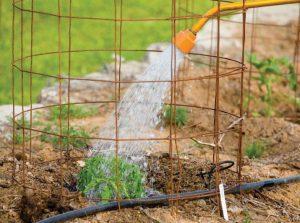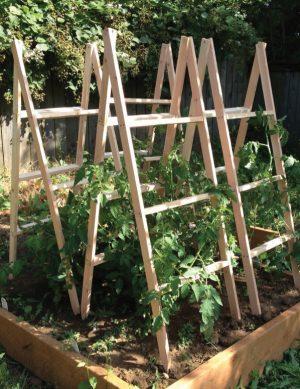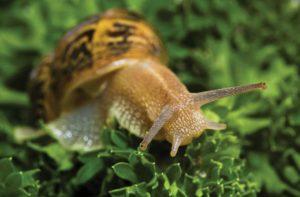 The tomato is probably the most popular vegetable grown by the home gardener. (Technically, the tomato is a fruit, not a vegetable). Their popularity is probably due to the fact that they are easy to grow, require little care and when ripened on the vine, taste so much better than those from the store.
The tomato is probably the most popular vegetable grown by the home gardener. (Technically, the tomato is a fruit, not a vegetable). Their popularity is probably due to the fact that they are easy to grow, require little care and when ripened on the vine, taste so much better than those from the store.
Planting
Since tomatoes take around 120 days to mature from seed, they are generally started indoors six weeks before planting in the garden. Or you may buy established plants from your garden shop.
 When you are ready to put the plants in the garden, make sure the night time temperature is not too cold (ideally above 50 degrees). Tomatoes are very sensitive to cold nights. They will either die or simply not grow until it warms up.
When you are ready to put the plants in the garden, make sure the night time temperature is not too cold (ideally above 50 degrees). Tomatoes are very sensitive to cold nights. They will either die or simply not grow until it warms up.
When transplanting, make sure you dig a hole large enough to accommodate the roots without crowding. Water the plant prior to removing from the pot.
 Here is another trick when transplanting that will give your tomatoes a strong, healthy root system. Remove all the lower leaves and branches from the plant (keep a minimum of three leaves). Dig a trench rather than a hole and plant the tomato horizontally with just the top foliage exposed out of the ground. Your tomatoes will grow new roots all along the stem everywhere it is under dirt and produce a vigorous plant.
Here is another trick when transplanting that will give your tomatoes a strong, healthy root system. Remove all the lower leaves and branches from the plant (keep a minimum of three leaves). Dig a trench rather than a hole and plant the tomato horizontally with just the top foliage exposed out of the ground. Your tomatoes will grow new roots all along the stem everywhere it is under dirt and produce a vigorous plant.
Watering
Water the new transplant thoroughly after planting; try to keep water off the leaves. Wet leaves promote fungus, disease and pests. Water the ground at the base of the plant. Avoid short, frequent watering. Water when the ground is dry to the touch 3-4 inches under the surface. Water long, slow and deep. Then do not water again until soil is dry. In some areas this may be every 2-3 days. In others, once a week. The plant will tell you when it needs water if you just observe closely. Look at the leaves in early morning or just before dark; if they are drooping. the plant probably needs water. Of course, if you just watered recently, the leaves may droop for other reasons.
Fertilizing
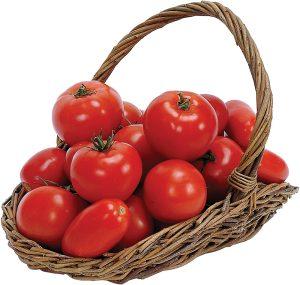 It’s fairly simple. You can have a great crop of tomatoes without any fertilizing at all, or poor crops when you do fertilize. So, what follows is only from my own personal experience. Others will advise various different procedures.
It’s fairly simple. You can have a great crop of tomatoes without any fertilizing at all, or poor crops when you do fertilize. So, what follows is only from my own personal experience. Others will advise various different procedures.
Incorporate fertilizer into the soil before planting your tomatoes. Then fertilize again when the first blossoms appear. Place fertilizer into the soil around the base of the plant and scratch it into the soil. Watering will take the fertilizer down to the roots. Do not fertilize again the rest of the season. Just keep in mind that over-fertilizing will promote large, vigorous plants with few tomatoes.
Care of Your Tomatoes
I like to prune my tomatoes as they are growing to keep them manageable and to allow light to get into the center of the plant. According to the variety, unpruned tomato plants can spread into a monstrous mess making it difficult to find tomatoes in the center and promoting disease/pests.
Culling is the technique of removing some of the tomatoes when they are small to allow the remaining tomatoes to have less competition for nutrients, thus growing larger. I have tried it and did not notice an appreciable difference. You might want to try culling one plant and not another (of the same variety in the same general location) and see for yourself if it helps.
Staking
It is very important to keep the leaves and tomatoes off the ground to prevent disease, pest and rot from invading your tomato plant. Some varieties do not need staking, others do. If you are not sure, just watch as the plant grows and if the leaves start to sag close to the ground, stake it.
There are a variety of commercially available staking methods (metal cages, plastic lattices, etc.) or make your own. Use a 6 or 8 foot wooden stake buried one foot into the ground. Use ties developed for this purpose (available at garden shops) and tie the wayward branches to the stake, beginning with the very first one. Never use thin string or wire to tie, it will cut into the limbs.
Pests
Snails/slugs: Snails may be picked by hand early morning, late afternoon or in the dark with a flashlight. If you are overwhelmed with snails or slugs you will have to resort to commercial solutions. There are many available and they are effective. However, be aware that many are poisonous to pets and children.
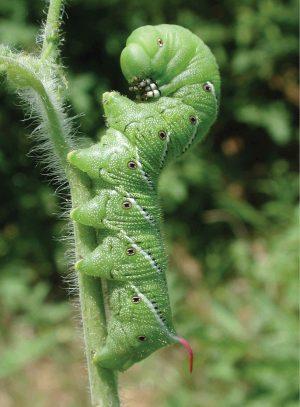 Tomato Hornworm: You will not have trouble recognizing one of these monsters if you have never seen one. First, you will notice an entire limb of your plant completely stripped of leaves. Then if you look closely in that area, you will see a large (2-4 inches long and 1/2 inch thick) worm with a pronounced horn on one end. They can be difficult to see since they are green and blend into the foliage of the plant.
Tomato Hornworm: You will not have trouble recognizing one of these monsters if you have never seen one. First, you will notice an entire limb of your plant completely stripped of leaves. Then if you look closely in that area, you will see a large (2-4 inches long and 1/2 inch thick) worm with a pronounced horn on one end. They can be difficult to see since they are green and blend into the foliage of the plant.
The simplest method to get rid of them is to pick them off by hand and dispose of them. I have never had to use any other controls for tomato hornworms. After picking them off for two or three days they do not reappear. If this method does not work, you will need to resort to a commercial pesticide.
There are many tips and different methods for growing tomatoes, but if you follow these basics, you will have a great harvest of beautiful tomatoes. ![]()
By the Garden Guru


